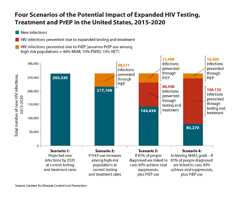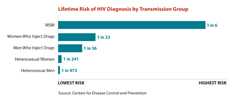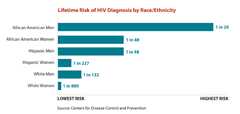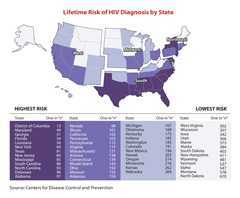2016 Conference on Retroviruses and Opportunistic Infections
February 24, 2016 – Conference on Retroviruses and Opportunistic Infections
CDC researchers will be presenting findings from more than 40 studies in Boston, Massachusetts from February 22-25, 2016 on the latest developments in the prevention and treatment of HIV and related infectious diseases.
CDC will debut new data on estimated lifetime risk of HIV diagnosis among specific populations, which show the disproportionate risk among gay and bisexual men of color.
CDC also released a new model of the impact of expanding the reach of key HIV prevention strategies, including testing, treatment and Pre-Exposure Prophylaxis (PrEP) uptake. Additionally, research studies on HIV testing trends can be found in the studies of interest.
Resources
- Press Releases:
- Studies of Interest: CROI 2016 Studies of Interest
CROI Graphics
The following images and graphics highlight major findings from CDC’s analysis. These high-resolution, public domain images are ready to download and print in your publication. Click on a graphic to see it in high-resolution.
These images are in the public domain and are thus free of any copyright restrictions. As a matter of courtesy, we ask that the content provider be credited and notified of any public or private usage of an image.
Four Scenarios of the Potential Impact of Expanded HIV Testing, Treatment and PrEP in the US, 2015-2020

View High Resolution Version
265,330 new infections could occur in the next five years, if current testing, treatment, and pre-exposure prophylaxis (PrEP) trends remain the same. If PrEP use increased among high-risk populations, 48,221 of those 265,330 new infections could be prevented. If NHAS strategy targets of 85% treatment and 80% viral suppression among those diagnosed are achieved and the use of daily (PrEP) increases, an estimated 185,000 new HIV infections could be prevented in the United States by 2020, a 70% reduction in new infections.
Lifetime Risk of HIV Diagnosis in the United States
 Lifetime Risk of HIV Diagnosis by Transmission Group
Lifetime Risk of HIV Diagnosis by Transmission Group
View High Resolution Version
Gay and bisexual men continue to be most affected by the HIV epidemic in the U.S. At current rates, 1 in 6 men who have sex with men (MSM) will be diagnosed with HIV in their lifetime, making them 83 times more likely than heterosexual men to be diagnosed with HIV in their lifetimes. People who inject drugs are also at increased lifetime risk for HIV.
 Lifetime Risk of HIV Diagnosis among MSM by Race/Ethnicity
Lifetime Risk of HIV Diagnosis among MSM by Race/Ethnicity
View High Resolution Version
While gay and bisexual men overall have the highest lifetime risk of an HIV diagnosis, that risk varies significantly based on race and ethnicity. At current rates, 1 in 2 African American MSM and 1 in 4 Hispanic MSM will be diagnosed with HIV in their lifetime, compared with 1 in 11 white MSM.
 Lifetime Risk of HIV Diagnosis by Race/Ethnicity
Lifetime Risk of HIV Diagnosis by Race/Ethnicity
View High Resolution Version
African American men overall are almost 7 times more likely than white men to be diagnosed with HIV in their lifetimes. The disparity among women is even greater: 1 in 48 African American women will be diagnosed with HIV in their lifetimes, compared with 1 in 227 Hispanic women and 1 in 880 white women.
 Lifetime Risk of HIV Diagnosis by State
Lifetime Risk of HIV Diagnosis by State
View High Resolution Version
People living in the South are more likely to be diagnosed with HIV over the course of their life than people in other parts of the country. States where risk is greatest include Maryland (1 in 49), Georgia (1 in 51), Florida (1 in 54), and Louisiana (1 in 56).
- Page last reviewed: February 24, 2016
- Page last updated: February 24, 2016
- Content source:


 ShareCompartir
ShareCompartir

